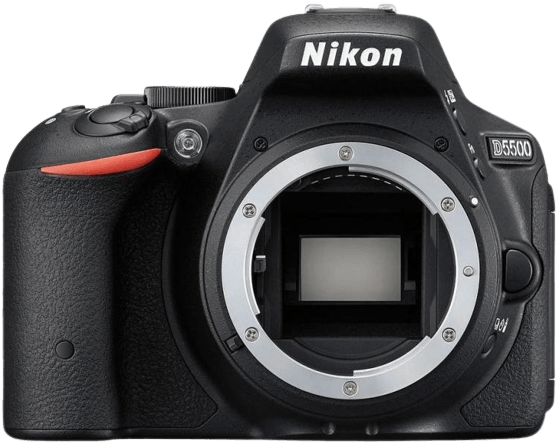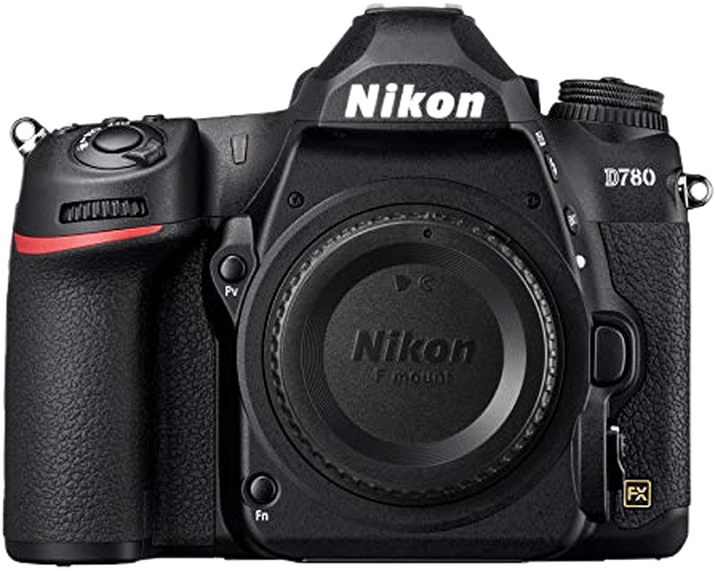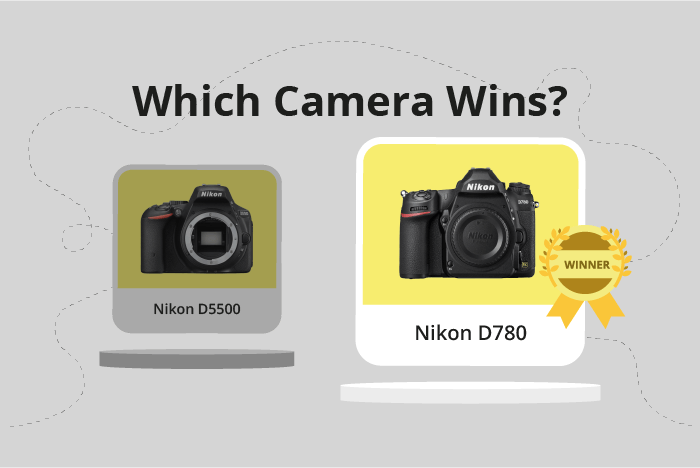Nikon D5500 vs D780 Comparison
Nikon D5500

Nikon D780

The Nikon D780 is the clear winner with a score of 81/100, while the Nikon D5500 scores 61/100. Both cameras are DSLRs and have similar features. However, the D780 excels in various aspects compared to the D5500.
The Nikon D780, released in 2020, is a more advanced camera with an impressive launch price of $2,299. It is larger and heavier, measuring 144 x 116 x 76mm and weighing 850g. This makes it more robust and suitable for professional use.
On the other hand, the Nikon D5500, released in 2015, has a lower launch price of $900. It is more compact and lightweight, measuring 124 x 97 x 70mm and weighing 420g. This makes it a better option for casual photographers and travelers.
While the Nikon D780 surpasses the D5500 in overall performance, the D5500 remains an excellent choice for those who prioritize portability and affordability. In contrast, the D780 is a superior option for professional photographers seeking top-notch quality and features.
Nikon D5500 vs D780 Overview and Optics
The Nikon D780 emerges as the winner in optics, scoring 77/100, while the Nikon D5500 trails behind with a score of 65/100. Both cameras share certain specifications, such as their CMOS sensor type, Nikon lens mounts, and the absence of image stabilization. However, there are a few key aspects that set these two models apart.
The D780 boasts superior specifications in terms of megapixels, shooting speed, processor, DXOMARK score for the sensor, and sensor size. With 25 megapixels, the D780 captures slightly higher resolution images than the D5500, which has 24.2 megapixels. The D780 also has a faster shooting speed of 12 compared to the D5500’s 5, allowing for better performance in fast-paced situations. The D780 uses the advanced Expeed 6 processor, while the D5500 relies on the older Expeed 4. This difference in processors leads to better image processing and overall performance for the D780. The D780’s sensor also receives a higher DXOMARK score of 97, compared to the D5500’s 84, indicating better image quality. Lastly, the D780 features a full-frame sensor, while the D5500 has an APS-C sensor, which gives the D780 an edge in low-light performance and depth of field control.
On the other hand, the D5500 has the advantage of a smaller and lighter body, making it more portable and easier to carry around for casual photography. This may be a determining factor for some users who prioritize convenience and portability.
Taking all of these factors into account, the Nikon D780 proves to be the better choice in terms of optics, outperforming the D5500 in several key areas such as image quality, speed, and sensor size. However, the D5500 remains a viable option for those who prioritize a compact and lightweight camera for everyday use.
Nikon D5500 vs D780 Video Performance
The Nikon D780 outperforms the Nikon D5500 in video capabilities, with a difference of 21 points in their respective video scores (91/100 for the D780 and 70/100 for the D5500). Both cameras share some common specifications, such as built-in time-lapse functionality, which allows for creative and dynamic video capture.
The D780 excels in video quality, offering 4K resolution with maximum video dimensions of 3840 x 2160, whereas the D5500 only supports Full HD with maximum dimensions of 1920 x 1080. This difference in resolution results in the D780 delivering significantly sharper and more detailed videos. Additionally, the D780 boasts a maximum video frame rate of 120fps, allowing for smoother slow-motion capture, while the D5500 is limited to 60fps.
On the other hand, the D5500 does not have any distinct advantages over the D780 in terms of video capabilities. Its lower resolution and frame rate make it less suitable for professional or high-quality video production.
Considering the differences in video resolution, dimensions, and frame rate, the Nikon D780 is the superior camera for videographers seeking high-quality and versatile video capture. The Nikon D5500, with its lower video score and capabilities, is more suited for casual users or those not prioritizing video quality. The D780’s advanced features make it a more reliable choice for capturing stunning videos, while the D5500 remains a budget-friendly option for those with less demanding video needs.
Nikon D5500 vs D780 Features and Benefits
The Nikon D780 outperforms the Nikon D5500 with a feature score of 87/100, compared to the D5500’s score of 59/100. Both cameras share several specifications, such as a 3.2-inch screen size, touchscreen functionality, flip screen, no GPS, and WIFI connectivity.
The D780 has a higher screen resolution of 2,359,000 dots, while the D5500 has a lower resolution of 1,037,000 dots. This difference results in sharper and clearer image previews on the D780. Additionally, the D780 has Bluetooth connectivity, which the D5500 lacks. This feature allows for easier pairing with compatible devices and remote control options.
On the other hand, the D5500 does not have any distinct advantages over the D780 in terms of features. Both cameras share the majority of their specifications, with the D780 having a few additional features that make it superior.
The Nikon D780’s higher feature score signifies its superiority over the Nikon D5500. With a better screen resolution and Bluetooth connectivity, the D780 offers more advanced and convenient options for photographers. The D5500, while still a capable camera, does not have any standout features that make it preferable to the D780. Therefore, the Nikon D780 is the better camera in terms of features between these two models.
Nikon D5500 vs D780 Storage and Battery
The Nikon D780 outperforms the Nikon D5500 in storage and battery with a score of 97/100, compared to the D5500’s 35/100. Both cameras share compatibility with SD, SDHC, and SDXC memory cards. However, the D780 has the advantage of two memory card slots and UHS-II compatibility, providing increased storage capacity and faster transfer speeds.
The D780’s battery life is also superior, offering 2260 shots per charge with its EN-EL15b battery, while the D5500 provides 820 shots with its EN-EL14 battery. Additionally, the D780 supports USB charging, making it more convenient for on-the-go use.
The D5500 does not have any advantages in storage and battery compared to the D780. The Nikon D780’s stronger storage features and longer battery life make it the clear winner in this category. This result further solidifies the D780 as a better camera choice for those prioritizing storage capacity and battery performance.
Alternatives to the Nikon D5500 and D780
Are you still undecided about which camera is right for you? Have a look at these popular comparisons that feature the Nikon D5500 or the Nikon D780:

